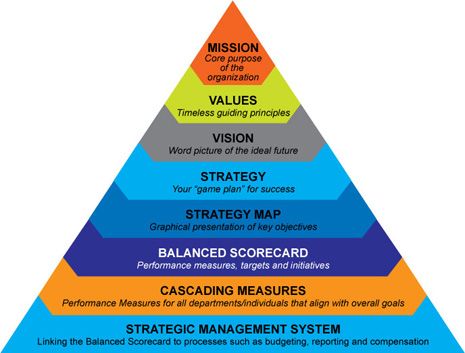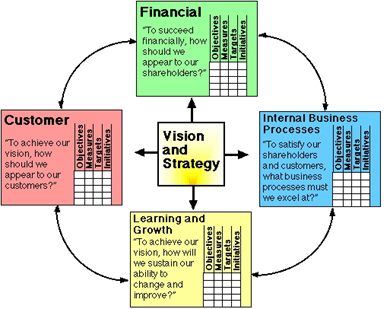Scorecarding, made popular by Kaplan and Norton and the Balanced Scorecard Consortium, is still seen as an executive or senior management tool. Stories abound of scorecarding projects which fail to deliver tangible benefits or are only implemented a couple of levels down in an organisation. That doesn’t need to be the case.
Often the block to effective scorecard implementations is identifying the correct KPI’s. We all know that “you get what you measure”, hence the reluctance to roll-out scorecards to a wider audience without confidence over the choice of the KPI’s. Chosing the correct KPI’s at every level in the organisation requires an intimate understanding of the operation of the business. Nimbus control-ES provides that process context.
We now offer scorecarding functionality based on Microsoft Business Scorecard Manager 2005. This scorecarding functionality is fully integrated into the process, document, compliance and action management capabilities of FINBRAIN-ITC control-ES to provide
an integrated Performance Management solution. Metrics, processes, roles and responsibilities are all presented in one coherent picture which everyone in the business can access and understand, with an auditable history of all changes.
However, we understand that with many projects, pinpointing Key Performance Indicators is still the easiest way of engaging senior management. Therefore many project start with just scorecarding, which is why we implement Microsoft Business Scorecard Manager 2005 in standalone projects where control-ES is not implemented.
For organisations already running scorecarding projects using other scorecarding applications who are keen to understand how to bring a process context to their metrics, we have developed integrations to:
- MSExcel – still the most popular, but it can do so much more using ODBC links
- Cognos ReportNet and MetricsManager
- SAP BW scorecarding and reporting
- Active Strategy scorecarding
- MSSQL – Use a SQL query to link to any metric in a MSSQL database
We are continuously developing new integrations- if you are using control-ES and need an integration with your current Business Intelligence / Scorecarding Solution
let us know… it may already be in the product roadmap
What are the four perspectives of the Balanced Scorecard?
The Balanced Scorecard method is a strategic approach, and performance management system, that enables organizations to translate a company’s vision and strategy into implementation, working from four perspectives:
- Financial perspective.
- Customer perspective.
- Business process perspective.
- Learning and growth perspective.
This allows the monitoring of present performance, but the method also tries to capture information about how well the organization is positioned to perform in the future.
What kind of benefits can I get off the Balanced Scorecard?
Kaplan and Norton cite the following benefits of the usage of the Balanced Scorecard:
- Focusing the whole organization on the few key things needed to create breakthrough performance.
- Helps to integrate various corporate programs. Such as: quality, re-engineering, and customer service initiatives.
- Breaking down strategic measures towards lower levels, so that unit managers, operators, and employees can see what’s required at their level to achieve excellent overall performance.
1. The Financial Perspective
Kaplan and Norton do not disregard the traditional need for financial data. Timely and accurate funding data will always be a priority, and managers will make sure to provide it. In fact, there is often more than sufficient handling and processing of financial data. With the implementation of a corporate database, it is hoped that more of the processing can be centralized and automated. But the point is that the current emphasis on financial issues leads to an unbalanced situation with regard to other perspectives. There is perhaps a need to include additional financial related data, such as risk assessment and cost-benefit data, in this category.
2. The customer perspective
Recent management philosophy has shown an increasing realization of the importance of customer focus and customer satisfaction in any company. These are called leading indicators: if customers are not satisfied, they will eventually find other suppliers that will meet their needs. Poor performance from this perspective is thus a leading indicator of future decline. Even though the current financial picture may seem (still) good. In developing metrics for satisfaction, customers should be analyzed. In terms of kinds of customers, and of the kinds of processes for which we are providing a product or service to those customer groups.
3. The Business Process perspective
This perspective refers to internal business processes. Measurements based on this perspective will show the managers how well their business is running, and whether its products and services conform to customer requirements. These metrics have to be carefully designed by those that know these processes most intimately. In addition to the strategic management processes, two kinds of business processes may be identified:
- Mission-oriented processes. Many unique problems are encountered in these processes.
- Support processes. The support processes are more repetitive in nature, and hence easier to measure and to benchmark. Generic measurement methods can be used.
4. Learning and Growth perspective
This perspective includes employee training and corporate cultural attitudes related to both individual and corporate self-improvement. In a knowledge worker organization, people are the main resource. In the current climate of rapid technological change, it is becoming necessary for knowledge workers to learn continuously. Government agencies often find themselves unable to hire new technical workers and at the same time is showing a decline in training of existing employees. Kaplan and Norton emphasize that ‘learning’ is something more than ‘training’; it also includes things like mentors and tutors within the organization, as well as that ease of communication among workers that allows them to readily get help on a problem when it is needed. It also includes technological tools such as an Intranet.
The integration of these four perspectives into a one graphical appealing picture, has made the Balanced Scorecard method very successful as a management methodology.
Objectives, Measures, Targets, and Initiatives
For each perspective of the Balanced Scorecard four elements are monitored (scored):
- Objectives: major objectives to be achieved, for example, profitable growth.
- Measures: the observable parameters that will be used to measure progress toward reaching the objective. For example, the objective of profitable growth might be measured by growth in net margin.
- Targets: the specific target values for the measures, for example, 7% annual decline in manufacturing disruptions.
- Initiatives: projects or programs to be initiated in order to meet the objectives
Double-Loop Feedback
In traditional industrial activity, “quality control” and “zero defects” were important words. To shield the customer from receiving poor quality products, aggressive efforts were focused on inspection and testing at the end of the production line. A problem with these approaches – as pointed out by Deming – is that the true causes of defects could never be identified, and there would always be inefficiencies because products with a defect are rejected. Deming understood that variation is created at every step in a production process, and the causes of variation need to be identified and repaired. If this can be done, then there is a way to reduce the defects and improve product quality indefinitely. To establish such a process, Deming emphasized that all business processes should be part of a system, with feedback loops. The feedback data should be examined by managers to determine the causes of variation, and what are the processes with significant problems. Then they can focus their attention on repairing that subset of processes.
The balanced scorecard method includes feedback around internal business process outputs. As in TQM. Additionally, the Balanced Scorecard provides a feedback for the outcomes of business strategies. This creates a “double-loop feedback” process in the balanced scorecard.
What kind of Outcome Metrics?
You can’t improve what you can’t measure. Therefore metrics must be developed based on the priorities of the strategic plan, which provides the key business drivers and criteria for metrics managers most desire to watch. Processes are then designed to collect information relevant to these metrics and reduce it to numerical form for storage, display, and analysis. Decision makers examine the outcomes of various measured processes and strategies and track the results to guide the company and provide feedback.
So the value of metrics is in their ability to provide a factual basis for defining:
Strategic feedback to show the present status of the organization from many perspectives for decision makers.
Diagnostic feedback into various processes to guide improvements on a continuous basis.
Trends in performance over time.
Feedback around the measurement methods themselves. Which measurements should be tracked?
Quantitative inputs for forecast methods and for decision support systems.
Management by Fact
The goal of measuring is to permit managers to see their company more clearly – from many perspectives – and hence to make wiser long-term decisions. A 1997 booklet on the Baldrige Criteria summarizes this concept of fact-based management:
“Modern businesses depend upon measurement and analysis of performance. Measurements must derive from the company’s strategy and provide critical data and information about key processes, outputs and results. Data and information needed for performance measurement and improvement are of many types, including: customer, product and service performance, operations, market, competitive comparisons, supplier, employee-related, and cost and financial. Analysis entails using data to determine trends, projections, and cause and effect – that might not be evident without analysis. Data and analysis support a variety of company purposes, such as planning, reviewing company performance, improving operations, and comparing company performance with competitors’ or with ‘best practices’ benchmarks.”
“A major consideration in performance improvement involves the creation and use of performance measures or indicators. Performance measures or indicators are measurable characteristics of products, services, processes, and operations the company uses to track and improve performance. The measures or indicators should be selected to best represent the factors that lead to improved customer, operational, and financial performance. A comprehensive set of measures or indicators tied to customer and/or company performance requirements represents a clear basis for aligning all activities with the company’s goals. Through the analysis of data from the tracking processes, the measures or indicators themselves may be evaluated and changed to better support such goals.”
Cautionary note on making use of the Balanced Scorecard
You tend to get what you measure. People will work to achieve the explicit targets which are set. For example, emphasizing traditional financial measures may encourage short-term thinking. The Core Group Theory by Kleiner provides further clues on the mechanisms behind this. Kaplan and Norton recognize this, and urge for a more balanced set of measurements. But still, people will work to achieve their scorecard goals, and may ignore important things which have no place on their scorecard.
Recent evolution of the Balanced Scorecard
In 2002, Cobbold and Lawrie developed a classification of Balanced Scorecard designs based upon the intended method of use within an organization. They describe how the Balanced Scorecard can be used to support three distinct management activities, the first two being management control and strategic control. They assert that due to differences in the performance data requirements of these applications, planned use should influence the type of BSC design adopted. Later that year the same authors reviewed the evolution of the Balanced Scorecard as shown through the use of Strategy Maps as a strategic management tool, recognizing three distinct generations of Balanced Scorecard design.

